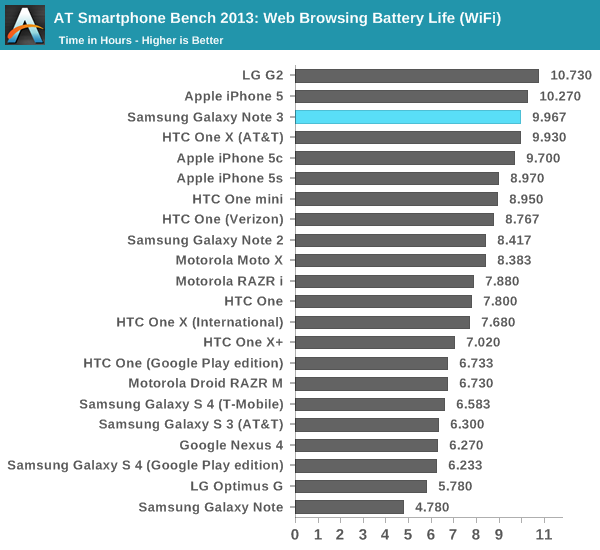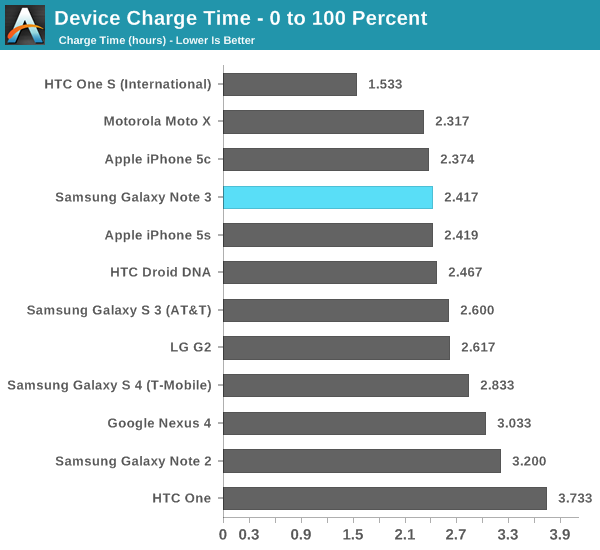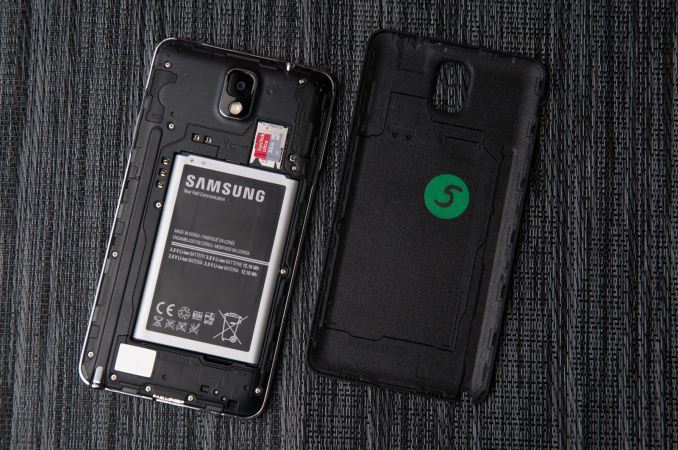Samsung Galaxy Note 3 Review
by Brian Klug on October 1, 2013 9:00 AM EST- Posted in
- Smartphones
- Samsung
- Mobile
- Android 4.3
- galaxy note 3
Battery Life
Battery life remains probably the single largest differentiator for devices lately, and of huge concern to enthusiasts and normal shoppers alike. We’ve already caught a glimpse of how well 8974 fares from a power perspective inside the LG G2, a device that posted some seriously impressive battery numbers. The Note 3 we’re looking at is also 8974 based since it’s a T-Mobile model, and thus we expect the same kind of battery life.
With this generation of Note, battery gets even larger. The Note started with a then quite large 9.25 watt hour battery, then Note 2 moved to 11.78 watt hours, and Note 3 now moves to a very large 12.16 watt hour battery with of course the newest 3.8V chemistry and all that comes along with it. Display size goes up, but those power gains are offset in other places.
After we talked about the panel self refresh features in the G2 a few people reached out and let me know that this feature has been shipping for a while in some phones, and it’s easy to check for. If we look under the display subsystem we can see that the same MIPI_CMD_PANEL type 9 is used, which refers to this type of interface.
Qualcomm HWC state: MDPVersion=500 DisplayPanel=9
define MIPI_CMD_PANEL ‘9’
Our battery life tests are unchanged and consist of a set of popular webpages that are loaded on a schedule with the display set to exactly 200 nits and repeated until the battery runs out and the device dies on both WiFi and cellular data connections. In this case that means T-Mobile LTE which is 10 MHz FDD in my market, I haven’t had a chance to run the Note 3 on HSPA+ yet, or complete the call test (which is starting to get ridiculous, and probably breaks 24 hours in the case of the Note 3).

On LTE the Note 3 does very well, coming just shy of the pack of iPhones, at just over 8 hours. Interestingly enough it’s just north of the G2s as well, which do have a smaller battery but also smaller display. The Note 3 also is the first device to ship with Qualcomm’s QFE1100 envelope tracker solution from the RF360 front end portfolio, which lowers power consumption by up to 20 percent and heat dissipation by up to 30 percent by allowing the power amplifiers to follow the desired output waveform. There’s more on that later in the cellular section.

On WiFi the Note 3 does better by 22 percent, but not the kind of huge jump I’m used to seeing between cellular and WiFi testing. This tells me the Note 3 battery life is really gated by the display, which is almost always the largest consumer of power in a device. That said the Note 3 does very well all things considered, especially in comparison to the APQ8064 (Fusion 3) phones which came before it, like SGS4. New silicon and new process inside MSM8974 definitely helps move battery life forward here with the race to sleep game.
Charging is an interesting story on the Note 3, but primarily because of what doesn’t change. The Note 3 continues to use Samsung’s tablet charging specification and charger, which has 2 amps of maximum output. The Note 3 draws 2 amps over a considerable amount of the charging curve, like other Samsung devices (in the linear part of the charge curve). USB 3.0 doesn’t change things up here quite yet with the new supported charge voltages that are coming eventually with the power delivery specification.

The Note 3 does charge faster overall compared to the SGS4 however thanks in part to the new PMIC (PM8941) which is part of the overall 8974 platform story.











302 Comments
View All Comments
yvn - Friday, October 4, 2013 - link
I was so close to getting this note 3 today but after playing with it i see this that display quality still not as accurate as I hoped to be. Even in the movie mode it gets fairly acceptable in terms of color accuracy but then the black and white photos look very very warm more like sepia toned and the white pages have a yellow tint. In dynamic mode the black and white photos look fantastic but then photos in color look awful, so disappointed i really liked the phone otherwisequestgraves - Monday, October 7, 2013 - link
Thank you so much for such an informative review. I am never let down by the work you guys do here at AnandTech. You have consistently fed me the information I so crave with a non-bias, facts are facts, specs are specs perspective. Your conclusions are based in reality with sound logic. I am grateful for the hard work you do to keep us brand-loyal techies rational.Davidjan - Monday, October 7, 2013 - link
Really love it. I would use it to see movies with Meenova MicroSD Reader: http://goo.gl/U6IyYESC2000 - Monday, October 7, 2013 - link
Okay anyone else think Ars Technica employees (or people Ars Technica hired) are posting over and over about the benchmark issue and how the Ars Technica's review is so great for publicity for their website? There must be 30 comments that not just raise the benchmark issue but also mention how great the Ars Technica review is...given how many note III reviews there are out there, why would every person mention the same one?Spunjji - Tuesday, October 8, 2013 - link
They mention the one article that deals most thoroughly with the benchmarking issues. There's no reason whatsoever to assume that they're employees, but there are almost certainly a few devotees of the site. The rest all appear to be idiots who enjoy overreaction.Optimummind - Friday, October 11, 2013 - link
Pretty good & decent review. I picked up a black Note 3 from AT&T and I really like its back texture. Feels like leather. The white one was my original choice but didn't like the texture at all.Gondalf - Sunday, October 13, 2013 - link
A little question to Brian Klug.Your reviews are very nice, still your power consumption pages are pointless .
Tell me the reason to measure the battery life running a web browser....and don't tell me that this is the more common usage because this is not true.
The real story is that you do not give the power consumption figure of this device (and many others) with the soc under stress. This Note 3 has a Snapdragon 800, that is famous to be power hungry, so stress it with a Game please, or stress the cpus with an online game client.
It is absurd your comparison, you can not compare Note 3 with other devices running the Qualcomm Soc at idle most time or at a low clock speed.
Please....you need to give the real figure of a product, beacuse this is useful for customer that do not want a device that shuts down after a little session of gaming.
Face it, the more common usage in handset is Gaming not web surfing.
aryanraj - Wednesday, October 16, 2013 - link
What do u think about Exynos Octa core variant of Note 3 and also why samsung is not able to integrate both the cores in the present note 3 . Only the A15 core works...loopybear - Thursday, November 14, 2013 - link
USB 3 connections.: Just purchased a SGNote 3 and everything seems fine except for the USB3 connection. Having found a suitable cable and connector I am unable to connect any of my 16gb usb 2 external memory chips to the phone. The phone does not even recognise their existence. Samsung blame the connector but I have my doubts. Can anyone else verify this? By the way the phone connects perfectly to my laptop.fareed0694 - Thursday, December 5, 2013 - link
Here is a complete guide to root and install clockworkmod recovery on Galaxy Note 3 of all versions. Visit here - goo(dot)gl/DojHhL